Music & Theater
The Ford also rises
October 9, 2014
With environmental approval this week of a transformative plan for the county’s John Anson Ford Theatres, the historic hillside facility is poised to stage its biggest comeback act since a fire wiped it out early in the last century.
Just as the current Ford rose from the ashes of that 1929 blaze, the revamped amphitheatre is expected to retain its historic charms while being modernized and reimagined to serve new generations of concert-goers.
In approving the environmental impact report for the Ford on Tuesday, the Board of Supervisors did not appropriate any funding for the project, which is intended to be built in phases.
However, thanks to previous appropriations from the 3rd Supervisorial District and the county, money already is in place to achieve one of the master plan’s most ambitious components: completing all restoration work and improvements involving the amphitheatre itself.
The facility will close throughout 2015 in order to replace the outdated and unevenly-surfaced stage, modernize the decrepit backstage area, upgrade aging electrical and audio-visual systems, improve accessibility and reengineer the site’s scenic but mudslide-prone hillside.
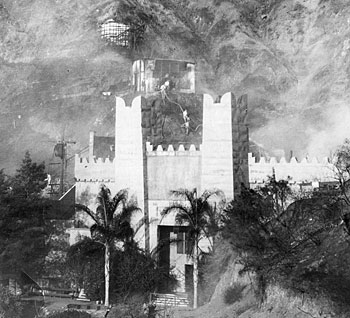
The original Ford was destroyed in this October 24, 1929 brushfire. Photo/Herald Examiner Collection, L.A. Public Library
In addition, with $28.5 million in additional funding recently approved as part of the county’s supplemental budget, the scope of the construction has broadened to include soundwalls to buffer the noise from the 101 Freeway, an expansive terrace where up to 200 people can enjoy pre-concert picnics, and a two-level structure with a new concession area on the first floor and offices for the Ford staff above.
“By combining the previously approved work with the new projects, we will be able to save several millions of dollars in construction costs,” said Laura Zucker, executive director of the Los Angeles County Arts Commission, which operates the Ford.
The current work—including earlier phases that involved developing the master plan and environmental impact report, replacing the amphitheatre’s seats and stripping away yellow paint to reveal its original concrete surface—has a total price tag of nearly $56.6 million.
Still to come in future years, once funding is identified, are a transportation plaza with a three-level parking garage, a restaurant, a 299-seat theatre and a ¾ mile-long hiking trail with majestic views of the Hollywood sign and other vistas.
Beyond new amenities, the work will address some longstanding problems that have plagued the 1,200-seat amphitheatre.
“It’s literally had mudslides going through it,” said Adam Davis, the Ford’s managing director of productions. “It’s kind of been neglected and this project is really going to help.”
The project’s architect, Brenda Levin, whose historic preservation work includes acclaimed projects at the Griffith Observatory, Wilshire Boulevard Temple and Dodger Stadium, said it is impossible to separate the Ford from its unique natural setting on county parkland in the Cahuenga Pass.
“The building itself is set deep into a canyon, and the canyon is very much part of the theatrical experience,” Levin said. “At the Ford you’re focused on the natural landscape, which will be maintained.”
By the time all the work described in the master plan is concluded, the public is likely to see the Ford and its surroundings in a dramatically different light, she said.
“I don’t think at this point that many people would describe the Ford as sitting in the middle of a 32-acre park,” Levin said. “I do think after this project is complete, they will totally understand that.”
Supervisor Zev Yaroslavsky, a longtime backer of the facility since he was elected to the county Board of Supervisors in 1994, said the coming work will be a game-changer for the Ford. “During my tenure we have continually made incremental improvements, but this really takes it to the next level,” he said. Yaroslavsky, who is retiring from the Board of Supervisors later this year, predicted that when the amphitheatre reopens in the summer of 2016, patrons will be in for their “best-ever Ford Theatres experience.”
Over the past two decades, the Ford has forged a unique identity among Los Angeles concert venues through its “partnership program” showcasing local artists, and more recently with its annual “Zev Yaroslavsky Signature Series” that aims to draw new audiences with programming pairing nationally known performers with homegrown talent.
With the Ford closing for construction next summer, plans are underway to bring a series of performances into various communities around the county.
Posted 10/8/14
Opera’s beach blanket bravura
August 27, 2014
It’s not every day that the sublime vocal talents of Plácido Domingo share a place in the sun with funnel cakes, caricature artists and an iconic ocean-front Ferris wheel.
But the tourist-friendly charms of the Santa Monica Pier will be meeting the glories of opera at its grandest when LA Opera brings its first-ever free live simulcast to the beach on Wednesday, September 17.
The high-definition broadcast of Verdi’s “La Traviata,” beamed live via satellite from the stage of the county Music Center’s Dorothy Chandler Pavilion to a giant screen on the pier’s wooden parking deck, ushers in a new tradition for the company, which plans to offer the program every other year.
“If I weren’t in the cast for this production, I’d want to be in the audience myself!” Domingo, the opera’s general director, said in a news release announcing “Opera at the Beach.”
Domingo is scheduled to sing the role of Giorgio Germont in a production that also includes soprano Nino Machaidze (as Violetta Valéry) and tenor Arturo Chacón-Cruz (as Alfredo Germont), with LA Opera music director James Conlon conducting.
“La Traviata” tells the story of a glamorous courtesan and her doomed love affair; NPR once dubbed it “the original Pretty Woman.” It opens LA Opera’s 2014-15 season on Saturday, September 13, with the beach simulcast taking place at 7:30 p.m. the following Wednesday.
For the production team, turning a day at the beach into a night at the opera has had as many complications as the most byzantine libretto.
“It’s been a big challenge. There are other opera companies that routinely do simulcasts, and we’re not one of them. For us this is the first time,” said Rupert Hemmings, the opera’s senior director of production. “The off-site logistics involved with setting up the pier and getting all of the equipment at that end and then of course the actual transfer of the product by satellite—all of that is new to us. It has been a steep learning curve, but I think we have everything in place for a success.”
The 21-by-40-foot screen, elevated on a six-foot-high platform, will be angled toward the ocean at the end of the pier’s parking deck. Folding chairs and blankets are recommended for spectators, who will be sitting on the deck’s rough-hewn wood beams, as they do for Santa Monica’s popular Twilight Concerts series. Although there is no charge for admission, the opera strongly encourages those who wish to attend to pre-order tickets online. (There’s a $1 handling fee for each order of up to 8 tickets.)
No alcoholic beverages are allowed, but there will be a designated beer garden. And while the simulcast is free, parking isn’t—so be prepared and perhaps consider reserving a space in advance.
The opera, underwritten with funds made available by Supervisor Zev Yaroslavsky, will be sung in Italian, with English translations superimposed on the screen during the simulcast.
With the advent of “Opera at the Beach,” L.A. joins a number of other cities where simulcasts have become a popular part of the cultural fabric, including San Francisco’s “Opera at the Ballpark” at AT&T Park and Washington, D.C.’s “Opera in the Outfield” at Nationals Park.
Whatever the locale, the name of the game is enticing new audiences to sample the art form, risk-free, while enjoying a communal event at a local landmark.
“I think that opera can be seen as elitist,” the opera’s Hemmings said. “I don’t feel it is, having been in it for most of my life, but I think when people can get out there and see this kind of thing for free—and see how much fun it is, and how emotionally stimulating it can be—that’s fantastic.”
LA Opera’s simulcast of “La Traviata” starts at 7:30 p.m. on Wednesday, September 17, at the Santa Monica Pier. Free tickets are available here, and directions and parking information are here.
Posted 8/27/14
L.A.’s free summer soundtrack
July 3, 2014
From Balinese gamelan music to mariachi spectaculars, jazzy interludes to multicultural pop, Los Angeles County is about to start grooving to the summertime beat of free music.
Nearly 60 free concerts are scheduled this season at parks and other public venues throughout Los Angeles County. Funded by the Board of Supervisors and sponsored by the county Arts Commission, the performances promise an incredible diversity of musical genres that give new meaning to the refrain “hot town, summer in the city.” Artists for just this month alone include Hound Dog Dave and the Mel-Tones, the UnderCover Girls, Samba Society and Julio Montero and the Far South Trio. The lineup of concerts in the 3rd District is here, featuring performances at El Cariso Regional Park, the Los Angeles County Museum of Art, Kings Road Park in West Hollywood and San Fernando Recreation Park. A schedule of what’s going on countywide is here.
And because this is Southern California, there’s an added bonus: the music doesn’t have to stop till October 19, when the Mariachi Divas bring down the curtain on the summer free concert season at Heritage Plaza Park in Covina.
Posted 7/3/14
Turning 50, to applause
April 3, 2014
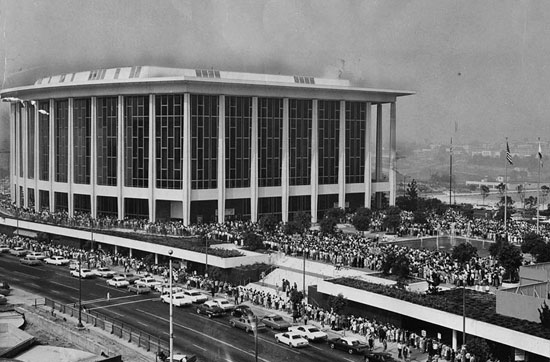
Within a year, the Music Center was a cultural fixture in L.A. Here, thousands of people line up for "Hello, Dolly" tickets. Photo/Herald Examiner
Like any grand dame, she avoids dwelling on birthdays. Still, a half-century is a milestone for a cultural icon in L.A.
So fans of the Los Angeles Music Center have gotten off to an early start in celebrating her upcoming 50-year mark. This week, a launch party on the Dorothy Chandler Pavilion stage kicked off a months-long celebration that will include some 60 large and small programs, including a gala on her December 6 golden anniversary and a public bash the next day on the Music Center Plaza.
“The Music Center has been critical to Los Angeles’ culture,” says Board Chair Lisa Specht. “We’re one of the top three performing arts centers in the country, along with Lincoln and Kennedy Centers, and for decades, we’ve been a hub of creativity.”
Not to mention a game-changer for L.A.’s metropolitan evolution.
“The Music Center was a major turning point in L.A. coming into its own in the postwar era as a major American city,” says Teresa Grimes, a Los Angeles historic preservation consultant who has documented the Center’s architectural heritage for past restoration projects.
Though the Los Angeles Philharmonic had been well established, it had no permanent home at the end of World War II other than the Hollywood Bowl, which was forced to close in 1951 due to a financial crisis, Grimes says. A series of “Save the Bowl” concerts, orchestrated by Dorothy Buffum Chandler, the wife of the Los Angeles Times’ publisher Norman Chandler, reopened the beleaguered band shell, but underscored the cultural shortcomings of the burgeoning city.
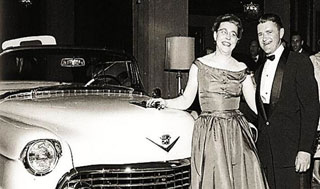
The winners of a Cadillac Eldorado, part of Dorothy Chandler's fundraising drive for Music Center construction.
Between 1951 and 1954, plans for a civic auditorium and convention center had been put on the local ballot three times, but never garnered the two-thirds majority it needed for passage. So in 1955, Chandler and the local Symphony Association began raising private funds for a hall to house the Philharmonic, which for years had been playing in leased space. As the highlight of their gala kickoff at the Ambassador Hotel, they raffled off a new Cadillac El Dorado.
“That was the beginning of it all,” Chandler is quoted as saying in Grimes’ Historic American Buildings Survey. “When we raised $400,000 in a few hours on El Dorado Night, I knew southern Californians wanted a music center badly enough to build it themselves.”
The effort took nearly a decade, at a time during which Downtown L.A. was being radically redeveloped. It required legislative approval and involved civic leaders from Donald Douglas to the Irvine family to Cecil B. De Mille.
Led by their arm-twisting society matron and her family newspaper, the Music Center boosters powered through social barriers dividing the Pasadena elite from Westside show business people, overcame pushback from provincial politicians, outlasted an economic downtown and triumphed in a last-minute squabble over whether the Center would be situated at First and Hope Streets, where the county wanted to put it, or at Chandler’s preferred location, the summit of Bunker Hill.
Chandler won, bumping the planned Department of Water and Power Building to the next block as the once-stately—and by now shabby—community of Bunker Hill was razed beyond recognition. She also brought on the architect of her choice, Welton Becket, who had worked with her on the Hollywood Bowl comeback and had master planned the campus of UCLA.
When Chandler decided during a visit to Europe that a single concert hall wouldn’t suffice, and that the new facility would do better financially if it also had a theater and a smaller forum, she won that battle also. Eventually, her tenacity in the project would put her on the cover of Time magazine.
The ultimate cost of the project was $33.5 million, with some $19 million of it from private contributions, including more than $2 million in small cash donations that local citizens dropped in so-called “Buck Bags” that were designed by Walt Disney and placed at cultural gatherings.
On December 6, 1964, the Dorothy Chandler Pavilion opened, resplendent with its crystal chandeliers and gold-leaf ceiling; the Mark Taper Forum and the Ahmanson Theatre were dedicated two years later. Opening night featured the renowned violinist Jascha Heifetz performing Beethoven’s Violin Concerto in D Major, and the Los Angeles Philharmonic conducted by a 24-year-old Zubin Mehta.
In the ensuing years, everyone who is anyone has performed at the Music Center, from Ingrid Bergman and Nat King Cole to Neil Young and Ravi Shankar. Esa-Pekka Salonen and Simon Rattle made their American debuts at the Music Center, as did groundbreaking productions from “Angels in America” to “Zoot Suit.”
Between 1969 and 1999, most of the Academy Awards ceremonies were held there. The Dorothy Chandler Pavilion is where Sacheen Littlefeather refused Marlon Brando’s Oscar, where a naked man streaked onto national television behind David Niven and where Sally Fields exalted at being really liked by the Academy.
And countless Angelenos have memories of youthful jobs as Music Center ushers.
“I worked there as an usher during my senior year of high school,” recalls William Estrada, now curator and chair of the History Department at the Natural History Museum of Los Angeles County. “It was the days of Zubin Mehta and we were required to wear these heavy, long Nehru-type jackets that were just awful to wear in the summer. Dorothy Chandler had her own parking space, and sometimes one of us was selected to walk her from her car to her seat.”
Today, Estrada notes, the Music Center, built on the site of the old Bunker Hill community, is just one cultural component in a downtown cityscape that is hardly recognizable compared to its pre-1960s, World War II incarnation. And it has expanded: The LA Phil is now housed at Disney Hall, the Center’s latest venue, and the L.A. Opera is at the Dorothy Chandler Pavilion.
Nonetheless, some things change more than others: this week’s anniversary kickoff was sponsored by Cadillac.
Click here to buy tickets to anniversary events and to share your memories of the Music Center, and here to volunteer.
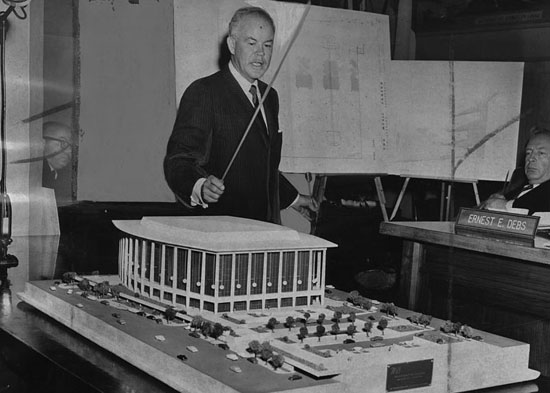
Architect Welton Becket presents plans for the new Music Center to the Board of Supervisors in 1960.
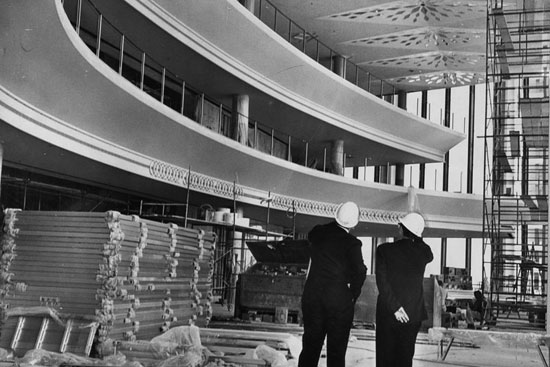
The Music Center was built as a public-nonprofit partnership on county land but was underwritten by private donations. Photo/Herald Examiner
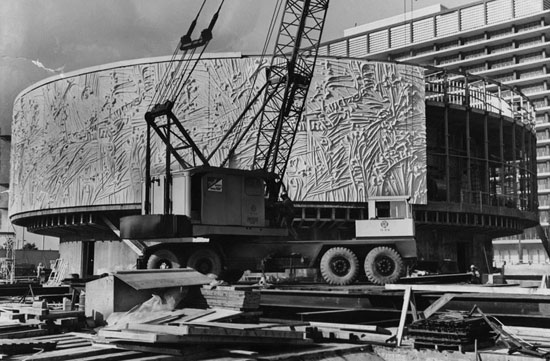
The Mark Taper Forum went up in 1966, covered with a mural of precast terrazzo. Photo/Herald Examiner
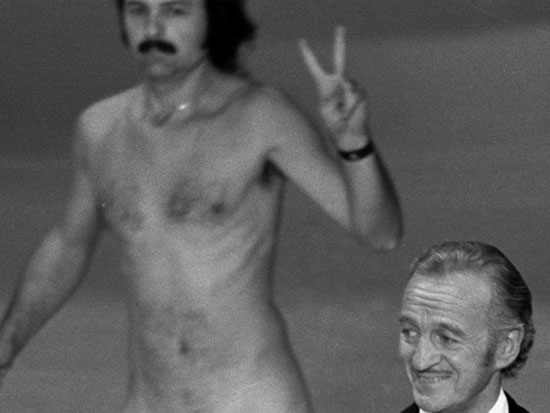
Some memorable moments occurred during the Music Center's reign as the Oscar's home. In 1974, a streaker crashed the party and actor David Niven's presentation.
Posted 4/3/14
A Strad-studded event
March 13, 2014

Elizabeth Pitcairn's Red Mendelssohn will be among eight Stradivari violins at the L.A.Chamber Orchestra's upcoming "Strad Fest" event. Photo/Joy Strotz
Jerry Kohl and his wife Terri are philanthropists from Pasadena and founders of the Brighton’s accessories chain. In their spare time, though, the Kohls are music lovers, and in 2006, they decided to buy one of the rarest and most coveted violins on the planet and make it available to musicians in Los Angeles.
“Stradivarius violins are like wines,” Kohl says. “There are good ones and then there are great ones, and all the great ones were being bought up by countries and museums, so it wasn’t going to be long before they were all gone. I wanted to see a great one here in L.A., and that’s how it started.”
Kohl called the curator of musical instruments at the Smithsonian for advice. He tapped Martin Chalifour, concertmaster at the L.A. Philharmonic. He called Margaret Batjer, the Los Angeles Chamber Orchestra’s concertmaster. He found dealers in London, Chicago and Vienna.
Finally, he narrowed his list to a handful of rare instruments, made during the brief “Golden Period” in which the legendary Italian luthier Antonio Stradivari was said to have done the work of a lifetime. Excitedly, he summoned all the dealers to Disney Hall for a play-off.
And when Batjer began to weep as she played the violin he eventually picked—a 1716 Stradivarius that had belonged to the virtuoso Nathan Milstein—Kohl says he realized he had witnessed “something magic”.
“It was as if she was playing a part of history,” he says.
Eight years later, Kohl and his violin are setting the stage for another magical and historical moment—one that, this time, will be open to all of L.A. From March 26-29, eight Stradivarii from the Golden Period will converge for an unprecedented series of concerts, inspired in part by the private “Strad fest” Kohl got to witness.
“Strad Fest L.A.” will feature some of the most storied instruments on the planet, played by some of the world’s finest musicians. Starting with a private March 26 reception for scholars at the Huntington Library, and encompassing public concerts in Downtown L.A. and Santa Monica before culminating at a Saturday night gala fundraiser, the series will feature not only Kohl’s violin but three other locally-owned Strads. Two will come to town with the violinists who’ll play them, while two more will be brought in from London by the son of Kohl’s dealer.
All told, the event will showcase many millions of dollars worth of 300-year-old masterpieces, a rare gathering, given that fewer than 650 of the 1,000 or so instruments made by Stradivari and his sons are still in existence, and only about 60 or 70 of them hail from the Golden Period, which—depending on collectors’ various definitions—ranges from about 1700 to the late teens or early 1720s.
And if some of the concerts have a “battle of the Strads” feel, it may be because Kohl—a major chamber orchestra supporter who made the largest monetary gift in the orchestra’s history last year—suggested the concept during a brainstorming conversation last year for the annual gala.
“I said, ‘For 300 years, scientists, musicians, violin makers, people of all sorts have tried to figure out why the Stradivarius is so magical’,” Kohl remembers. “’So why don’t you honor the violin?’”
The suggestion became “an inspiration,” the L.A. Chamber Orchestra’s executive director, Rachel Fine, says. “We realized there were actually quite a few Stradivari violins right here in town.”
Last season, for instance, Dr. William Sloan, a urologist and amateur violinist from Los Feliz, and his law professor wife, Judy, had loaned their 1714 “Leonora Jackson” Stradivarius to the orchestra’s assistant concertmaster for a world premiere. Violinists at the L.A. Philharmonic had access to several in the Phil’s collection, including the 1711 Stradivarius formerly owned by the great composer Fritz Kreisler.
The 1720 “Red Mendelssohn” Stradivarius that inspired the Academy Award-winning film, “The Red Violin” has been owned for years by violinist Elizabeth Pitcairn, who teaches at the Colburn School downtown.
Then there were all the friends of musicians at the chamber orchestra who had Stradivarius connections. Cho-Liang Lin, the music director of La Jolla Music Society’s SummerFest, owns the 1715 “Titian” Stradivarius, which is revered for its orange-red color and unusual power. Philippe Quint plays the 1708 “Ruby” Stradivarius, thanks to the Stradivari Society, which loans it to him.
“We started adding more and more Strads and more and more players who could play them,” says the chamber orchestra’s general manager, Andrea Laguni. “And then we decided that it seemed unfair to share this only with the few people who could attend the gala.”
So, Laguni says, they added the Huntington event “to share with another cultural institution and their base of donors,” and then inserted a cameo Strad appearance into an already-planned Thursday night Baroque Conversation. By that time, he says, it seemed only fitting to throw in the Friday night “FiddleFest” at Santa Monica’s Broad Stage, at which the violinists will attempt to outplay each other in a program of solos, duos, trios and quartets. Tickets for that event start at $45; the gala is $750 a head.
The planning took the better part of a year, Laguni says, although it was simplified by the fact that half of the violins—and half of the violinists—are from Greater L.A.
The musicians will range from world-renowned players like Chalifour to newcomers like Ray Ushikobo, a 12-year-old Riverside prodigy. And most will bring violins that they own or that are regularly on loan to them. The exceptions will be Ushikobo and Xiang Yu, another prizewinning young violinist; their violins—the 1666 “Serdet” and the 1720 “Beechback”—will be brought in for the occasion by the son of London violin dealer and expert Charles Beare.
Physician Sloan, who plays his Strad in a string quartet when he’s not loaning it out to professional musicians, says he plans to attend all but one of the StradFest concerts.
“Hardly anybody has ever heard eight Strads together—people buy them and hoard them,” he says. “Years ago, soloists had them, but now they’re so expensive that when the soloist dies and the family sells them, they go through banks or Fortune 500 collectors, like they’re boats or artworks or commodities.”
Periodically, a Stradivarius is stolen, although Laguni says their fame makes them almost impossible to resell. More typically, unscrupulous dealers try to fob off fakes and copies onto unsuspecting collectors, or super-rich investors buy them and take them out of commission. Many of the Stradivari violins in existence have ended up in museums, their famous, rich timbre forever silenced in the name of preservation.
“Every time a government or museum buys one, it’s off the market forever,” says Kohl, who keeps his “Milstein” in a downtown vault when it’s not being borrowed by musicians like Batjer or Chalifour or John William, who recently used it for a performance of the theme from “Schindler’s List” in Orange County.
So has he ever tried to play his?
“Oh, no, no, never, never, never, no,” the music lover says, laughing. “I’m not that brave.”
His preference, he says, is to sit in the audience, to listen and appreciate.
“You can sit in the last seat in the house and hear it,” Kohl says. “It just has this sound that just carries, that you can’t turn away from. It’s like Frank Sinatra walking into a restaurant—you notice. It’s magic. It’s going to be great.”

Los Angeles Philharmonic Concertmaster Martin Chalifour will be bringing one of the orchestra's Strads to the party. Photo/Eric Chalifour
Posted 3/13/14
Good news for Bowl bottoms
March 5, 2014
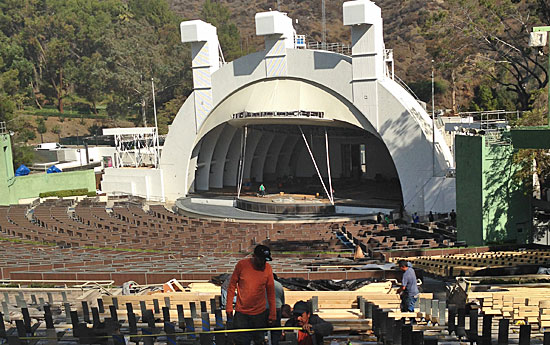
Alaskan yellow cedar benches are going in at the Bowl, replacing old ones that have seated millions.
Consider the lot of the lowly Hollywood Bowl benches.
Every summer, they bear silent witness to sublime symphonies, cool jazz and the musical stylings of some of the biggest names in pop. They brave the elements year ‘round, and when the amphitheatre is in full swing, get up close and personal with some 14,000 rear ends a night (some shielded with cushions, others not so much.)
Is it any wonder that eventually even the staunchest Bowl bench starts to crack under all the pressure?
But relief is on the way for the current crop of benches, which were installed at the dawn of the Reagan Administration and have hosted more than 18 million backsides in their time.
Mark Ladd, the Bowl’s assistant director of operations, calls the bench replacement “a once-in-a-career project.”
“It’s exciting to see it get done,” Ladd said. “If you take a look at some of the older wood, you’ll see it’s overdue.”
Underwritten by Prop. A park improvement dollars and other funds made available by Los Angeles County Supervisor Zev Yaroslavsky, the $1.6 million project is expected to wrap up in time for this year’s opening night on June 21. (Concertgoers for this year’s pre-season lease events like Black Sabbath, Billy Joel and Bruno Mars and Pharrell Williams will see a work in progress, with a mix of old and new benches available for seating.)
Beyond putting to rest the occasional splinter complaint, the new seats—which, like the earlier benches, are made of golden-hued Alaskan yellow cedar which will weather in time to a silvery gray—will be visually striking in their inaugural season.
And they’ll be widely used. While some music fans pony up for pricey box seats, the vast majority of Bowl patrons flock to the benches, where some weeknight concert tickets can be had for little as $1. (Another buck rents you a cushion for the night. For more on that and other tips for making the most of your Bowl experience, click here.)
The bench replacement project is part of a long list of improvements that have gone into the county-owned facility in recent years, including replacement of the legendary shell itself. New restrooms, park furniture to make it easier for more people to picnic at the site, “speed ramps” to whisk patrons to the Bowl’s upper levels, LED screens, a wine bar and a state-of-the-art sound system are among the upgrades in the just the past few seasons. (Industry professionals seem to be noticing; the Bowl recently nabbed its 10th straight Pollstar award as the nation’s best major outdoor concert venue.)
In addition to the new benches, this summer season will also be illuminated with new landscape lighting around the site, also funded by Yaroslavsky’s office. And the Los Angeles Philharmonic, which operates the Bowl under a lease agreement with the county, is replacing the stage floor, a maintenance procedure it undertakes every 10 years or so.
As construction workers buzzed around the site this week, assistant operations director Ladd noted that those venerable Bowl benches, installed back in 1981, may still not have reached the end of their long service to the people of Los Angeles County.
“We’re looking to re-use as much as we can,” Ladd said, pointing out that the wood can be re-milled and made available for repairs and future construction projects throughout the county parks system—an environmentally-friendly encore worthy of the Bowl itself.
Posted 3/5/14
We loved them yeah yeah yeah
February 6, 2014
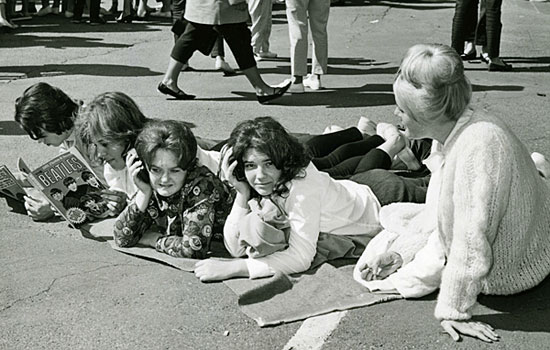
Fans mobbed the Hollywood Bowl for tickets to the Beatles' 1964 Los Angeles debut concert. Photo courtesy of The Music Center Archives/ Otto Rothschild Collection
It was 50 years ago this summer that four lads from Liverpool took the stage of the Hollywood Bowl, ushering in Beatlemania, Los Angeles-style.
Before the end of their 30-minute set on August 23, 1964, this much was certain:
A long-running love affair between the Beatles and Los Angeles was underway. Initially it involved mass hysteria, stealthy getaways, partying with local swells and celebrity hobnobbing on the Sunset Strip. Eventually it blossomed into “Breakfast with the Beatles,” a record label romance, a song, an uncomfortable meeting with Elvis in Bel-Air, even a Tower Records commercial.
At the same time, the Bowl itself was experiencing an electrifying new chapter in its fabled history, as a generation of screaming teenagers converged on the place where their parents had thrilled to popular stars like Frank Sinatra and classical music greats like Jascha Heifetz and Vladimir Horowitz.
Suddenly, it was a whole new ballgame.
“I think that night in 1964, that’s the most famous concert in American history, not counting Woodstock,” said Bob Eubanks, then a 26-year-old Los Angeles deejay and owner of two “Cinnamon Cinder” nightclubs, who produced the Beatles show by mortgaging his house for $25,000. “The boys at the Hollywood Bowl told us we couldn’t sell this thing out in one day, that it was physically impossible. Well, we sold it out in 3½ hours—without computers, by the way—and away we went.”

Paul McCartney backstage at the Bowl in '64. Photo courtesy of The Music Center Archives/ Otto Rothschild Collection
Along with thousands of smitten schoolgirls, stars like Lauren Bacall, Debbie Reynolds and Michael Landon turned out for the performance. Gossip queen Louella Parsons had to be relegated to the back benches—“she let us know about that for a long time,” recalled Eubanks, who went on to national fame as host of “The Newlywed Game.”
Ticket prices ranged from $3 to $7. Fans who couldn’t get in climbed trees around the amphitheater as “Twist and Shout,” “Can’t Buy Me Love” and “I Want to Hold Your Hand” rocked the Cahuenga Pass. After the final number, a cover of the Little Richard hit “Long Tall Sally,” the band was whisked away in a tiny compact car and was getting off the 101 Freeway at Sunset Boulevard before the audience knew what hit them. “The kids still thought they were there and they ruined two limos out back,” Eubanks said.
From his vantage point as a deejay at KRLA, the city’s top rock ‘n’ roll radio station at the time, Eubanks had known for months that something big was on its way.
“Suddenly, there were these four guys from England who just changed the world musically,” he said. “Our phones just started to ring off the hook…It started the night they did the Ed Sullivan show, quite frankly. When we heard they were coming to America, the country started to really buzz.”
This year, the buzz is back. With the 50th anniversary of the group’s first appearance on the Sullivan show taking place this Sunday, February 9, there’s no shortage of magazine covers and think pieces analyzing the British Invasion. And the Hollywood Bowl, where L.A.’s adventures in Beatlemania began, this week announced that it is marking the occasion with three “The Beatles’ 50th at the Bowl” concerts in August. (Those aren’t the only ‘60s flashbacks in store at the Bowl, by the way; the summer schedule also includes performances of the musical “Hair”—complete with “simulated drug use” and “brief nudity.” Check out the complete Bowl schedule here.)

Fainting girls went with the territory. Photo courtesy of The Music Center Archives/ Otto Rothschild Collection
Dave Stewart (of Eurythmics fame) will be “ringmaster and musical director” for the August 22, 23 and 24 Beatles shows at the Bowl, which will include yet-to-be-announced special guests and a re-creation of their original musical set from 1964.
Eubanks said he’d like to take part in the shows if possible. As the 50th anniversary approaches, he has also reached out to Paul McCartney. In an email reply, read by Eubanks in a telephone interview this week, the former Beatle demurred about his availability on the anniversary date but sent along reminiscences of the “heady days of our early trips to L.A.” and this message to fans:
“It was a fantastic time for us and I still have many memories of the things that we got up to. It was great to play the Hollywood Bowl even though our music was completely drowned out by the screams of our lovely fans.”
The Hollywood Bowl Museum is gearing up for the occasion as well. Carol Merrill-Mirsky, museum and archives director for the museum and the Los Angeles Philharmonic, which operates the county-owned Bowl, has commissioned a 3-D model of the Beatles in concert. It will be showcased this summer along with the small cache of Beatles memorabilia—including a copy of Eubanks’ contract for the 1964 concert—that’s on regular display.

Tickets for the 1964 show sold out in 3½ hours. Photo courtesy of The Music Center Archives/ Otto Rothschild Collection
She also has been combing through old pictures from the Music Center archives to put on display—although there are not a lot of images in the collection from that initial concert. She thinks that’s because, aside from Eubanks, few saw the magnitude of what was about to unfold that night.
“He had an instinct that it was going to be huge but nobody else did. Nobody. Certainly the Bowl didn’t, and the fact that we have so few photographs is proof that it was not a big deal. But it was a big deal to the fans—to those teen fans.”
Despite the frenzy among local teens, not everyone was thrilled to see the Fab Four arrive in Los Angeles in 1964. “They wanted to stay at the Ambassador, but the Ambassador didn’t want ‘em,” Eubanks remembered. A house in Bel-Air, complete with “a pool and the whole nine yards,” was lined up instead.
On the night of the concert, a busload of marshals showed up at the Bowl, ready for deployment to “protect the neighbors up in the hills.” Eubanks thought it was a great idea until he realized he was going to be footing the bill.
As a result, he said, he ended up making only about $4,000 on the 1964 concert. But Eubanks, who went on to produce all of the Beatles’ L.A. concerts—two performances at the Hollywood Bowl in 1965 and a 1966 show at Dodger stadium—did “quite well, thank you” on the later gigs.
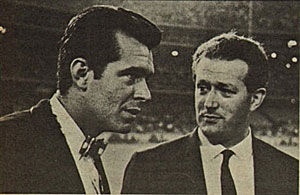
Eubanks, with Beatles publicist Tony Barrow at Dodger Stadium in 1966, witnessed the band's evolution.
He also had the priceless experience of seeing the band’s three-year evolution—from “wide-eyed and curious” in 1964 to seasoned “road warriors” in 1965 to “very difficult” in 1966.
After the last-ever Los Angeles show in 1966, he remembers arguing with John Lennon in the Dodgers’ dugout after the original getaway car failed to make it out of the stadium.
“We got into it pretty good with John down there because he wanted to get to a party. ‘You’ve gotta get us out of here.’ We went nose to nose. And finally I said, ‘I’ll get you out of here.’ We went upstairs and put them in the back of an ambulance.”
The driver “was nervous as heck. He drove right down through 40,000 people…he hit a speed bump and the radiator fell out of the ambulance.”
Finally, they reached a rendezvous point with an armored car that was intended to complete the trip away from the stadium. But it was mobbed with teenage girls and the Beatles’ escape seemed to be foiled again.
“And all of a sudden, I have no idea where they came from, the Hells Angels showed up,” Eubanks said. “They circled the armored car, the kids backed off, and the Hells Angels led the Beatles from Dodgers Stadium. And that was the last time I saw the Hells Angels or the Beatles.”
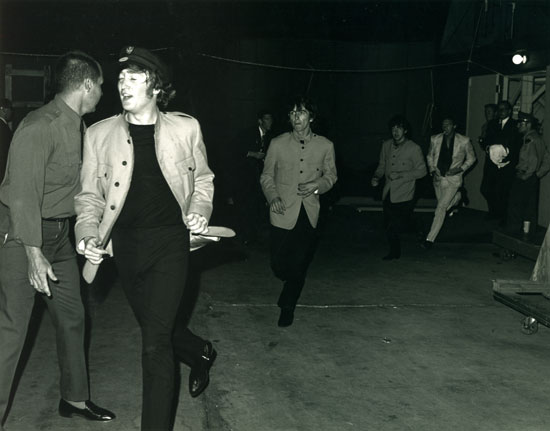
Running into the Bowl in 1965. Photo courtesy of The Music Center Archives/ Otto Rothschild Collection
Posted 2/6/14
Making spirits bright
December 6, 2013
The holiday season demands a soundtrack, and for many musicians, this is one of the busiest times of the year.
Just ask Jane Sarture what her ensemble is up to these days.
“We played this morning in a real estate office,” Sarture said. “We’re going to go out to hospitals, senior centers, the Ronald McDonald House charity Christmas party. We’ll be playing at Olive View hospital. We’re going to be at the Kaiser farmer’s market… I don’t think I ever stopped to count yet but I think we have 25 performances across 24 days.”
Sarture is a music director, but she’s not leading a local orchestra, singing group or jazz combo. Her musicians are developmentally disabled adults who play in the ARC Handbell Choir.
Their rendition of “Jingle Bells” may not be the slickest version you’ll hear this season, but it’s undoubtedly the most heartwarming.
“It is inspiring,” said Sarture, 52, a former associate producer of television game shows who switched careers to work at ARC 22 years ago and now accompanies the group on keyboard during their performances.
“The first day I walked in, I was like, “This is so cool.’ It’s like that old cliché: it’s not a job, it’s a calling,” she said of her work at the non-profit ARC (Activities Recreation and Care). The North Hollywood organization offers adults with cognitive disabilities a chance to take part in a wide range of life-enriching activities, from camping and field trips to volunteering at senior centers and even running marathons. The handbell choir is one of the most visible manifestations of the organization’s mission; they’ve performed 11 times since 1999 in the county’s Holiday Celebration, which is broadcast live on KCET. (This video captures one of their previous performances.)
This year, they’re returning to the stage of the Dorothy Chandler Pavilion for the 12th time to perform in the annual Christmas Eve extravaganza, produced by the county Arts Commission and featuring an array of performers in many genres. If past experience is any indication, look for the audience to respond to the handbell choir with a rousing ovation—and perhaps a discreet tear or two.
“People are amazed,” said Jennifer Davis, an ARC employee who conducts the ensemble’s performances and also serves as the organization’s volunteer marathon coach. She ran the New York Marathon this year with ARC client Jimmy Jenson, who has Down syndrome and received national acclaim on the “Today” show for his accomplishment.
“A lot of times people see the young, cute babies and they don’t know what happens [to the developmental disabled] when they grow up,” Davis said. “You’ll see people with tears streaming down their faces and they’ll say ‘I have a six-year-old and to think that my child can grow up and live such a phenomenal life.’ ”
Davis said an overarching message behind the group’s success is a determination to look past what people can’t do and focus instead on what each individual is capable of.
“When we look at what we can do, and what we can contribute, that’s when community and the real music in life happens,” she said.
ARC’s handbell choir has been jingling all the way since 1985 and now performs year-round.
They don’t charge for their performances, but happily accept donations, which Sarture said can range from “a great lunch and a couple of candy canes” to a check for $50 or even $2,000.
It all comes in handy when you’re trying run a handbell choir.
“It’s an expensive operation,” Sarture said. “If you drop a bell, it’s $200.”
There’s plenty of music in the air, but one thing you won’t hear from this group is any complaining about how busy things get when the holidays roll around.
“It’s amazing,” said one performer, 34-year-old Hillary Shaw, after an evening performance at a holiday open house in Supervisor Zev Yaroslavsky’s Van Nuys district office this week.
And as for Sarture? “It’s a blast,” she said. “It’s my favorite time of the year.”
Posted 12/6/13
Veterans come in on a high note
September 26, 2013
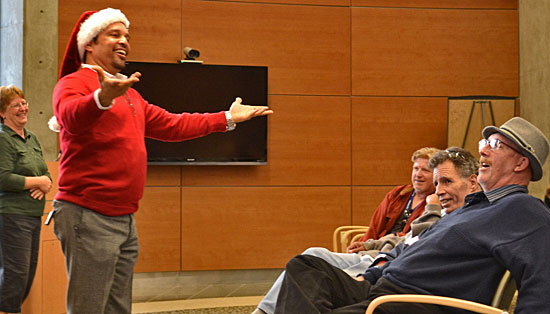
Performance tickets and holiday recitals are just part of the program as LA Opera reaches out to vets.
When “Carmen” struts her stuff on the Dorothy Chandler Pavilion stage at this Sunday’s matinee, there’ll be all the passion, lyricism and high drama you’d expect from Bizet’s operatic masterwork.
And, sitting in some of the best seats in the house, there’ll be a group of audience members you wouldn’t necessarily expect to find soaking up all that tempestuous romanticism: U.S. military veterans, growing into opera buffs thanks to an LA Opera program now entering its second year.
The veterans’ program is part of LA Opera’s Community Circle outreach, which makes thousands of tickets available each season to non-profit and community groups. Some pay a sharply discounted rate of $9 apiece for the tickets, which ordinarily go for about $105, while others, like veterans, get in free.
As a result, veterans from residences for retired military personnel in West L.A. and Long Beach have been getting a taste of the art form that some had known only from the movies—if at all.
“Last year, they saw four operas—Madame Butterfly, Tosca, The Flying Dutchman and Cinderella—and many of the vets were first-time opera-goers,” said Stacy Brightman, LA Opera’s director of education and community programs.
Millie Taylor, 89, who served as a Navy nurse during World War II and now lives at the Veterans Home of California in West Los Angeles, is relishing the prospect of seeing “Carmen,” conducted by Placido Domingo, no less.
“I love the music and the dancing and all the fiery action,” she said. “The costumes are just out of this world. I’m really looking forward to it.”
Taylor, who had never been to the opera before last year, reveled in the personal attention and great seats her group received—“just like paying customers.”
While some of the 16 West L.A. Veterans Home residents heading to the opera Sunday will be neophytes, Sadie Sonnenreich is not among them. The 99-year-old Army veteran says she’s been enjoying opera for half her life.
“It’s the music itself. I love the opera songs,” she said.
The opera’s outreach to vets isn’t limited to the performance tickets; speakers also present pre-opera talks at the residences to explain plot nuances and introduce some of the vocal talents they’ll be hearing. Opera artists also have performed holiday recitals for the veterans.
“People ask, why veterans? Well, who better than veterans?” LA Opera’s Brightman said. “We try to have each group come no more than once a year, but the veterans are the one we break our rule for. Their service to us all is so astonishing. It’s an honor to do anything we can for them.”
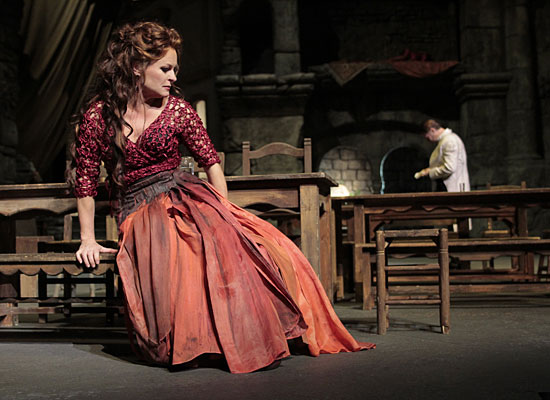
Veterans will see Patricia Bardon performing the title role in "Carmen" Robert Millard photo/LA Opera
Posted 9/26/13





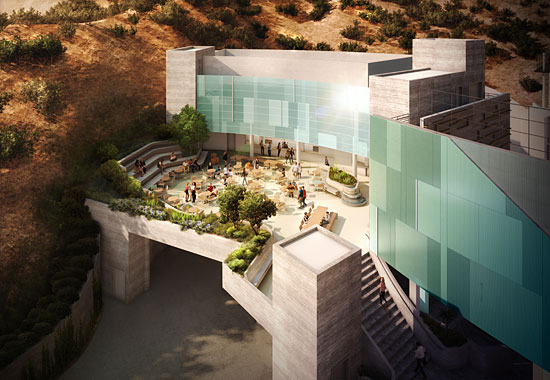

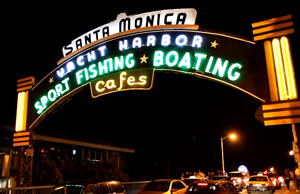
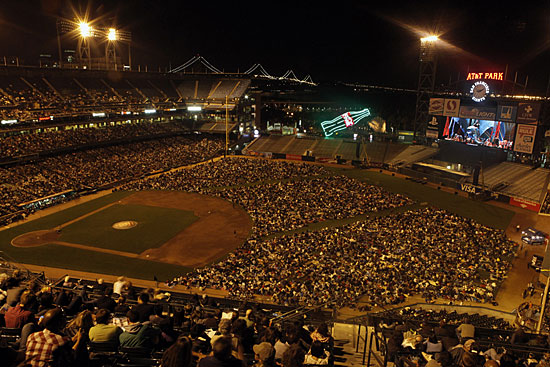
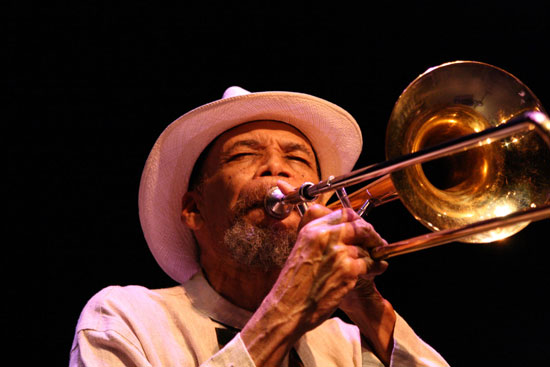
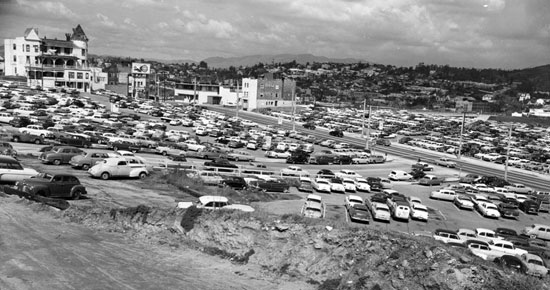

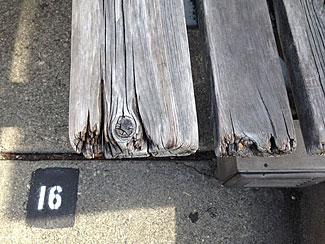
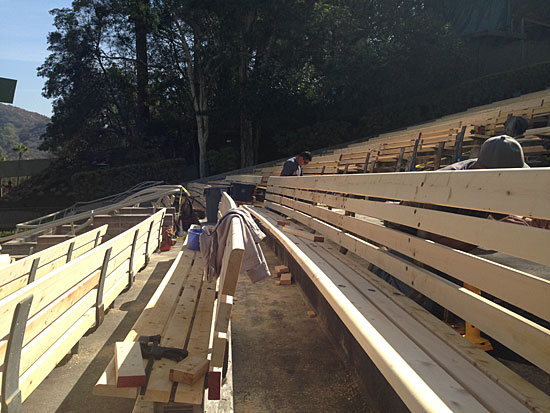
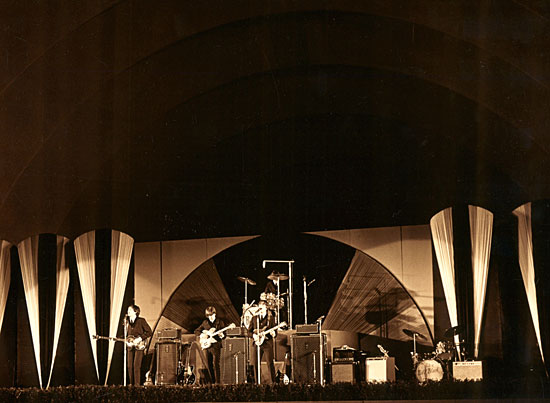
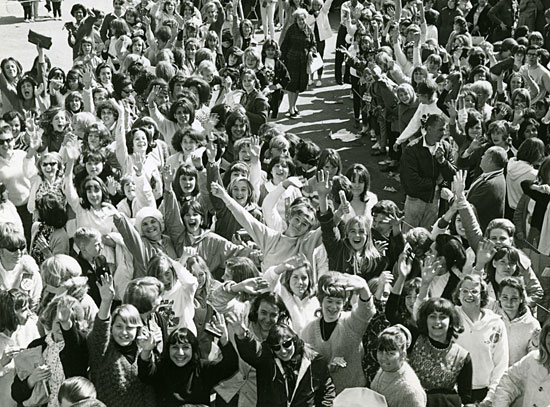
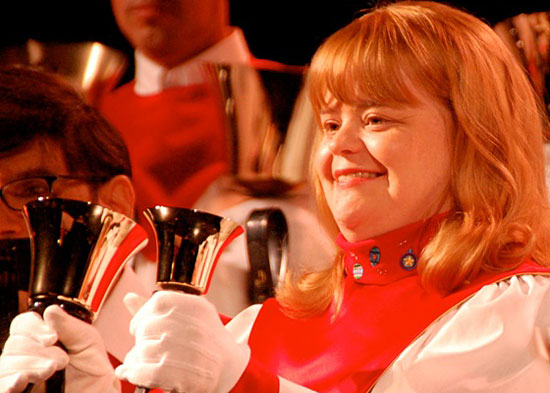

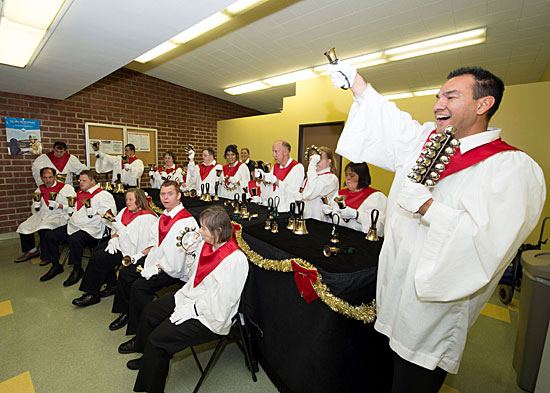









 405 bridge work causes a stink
405 bridge work causes a stink